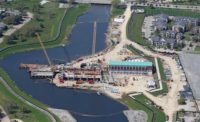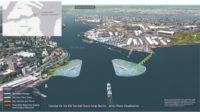A $4.6-billion U.S. Army Corps of Engineers proposal to protect Miami from future storm surge, largely by building massive sea walls and elevating infrastructure systems, is the latest of such plans the agency has developed for East Coast communities.
On June 5, the Corps unveiled a draft of the Miami-Dade Back Bay Coastal Storm Risk Management Feasibility Study, including its proposed plan to protect the most vulnerable parts of the region, and held virtual public hearings on the study June 9 and June 11. The Corps is also developing similar programs for Charleston, S.C., and the Florida Keys.
The Corps says the final Miami-Dade study is anticipated in 2021. “It’s an evolving plan,” says Holly Carpenter, project manager for the Miami-Dade study.
The protection plan calls for six miles of sea walls, ranging in height from 1 ft to 13 ft, plus elevation and protection of critical infrastructure and thousands of homes. Under the proposal, levees would be built along the Miami and Little rivers and Edgewater neighborhood, while levees and floodwalls are proposed around the Biscayne Canal. Total design and construction costs are estimated to be about $1.22 billion, according to the Corps proposal.
Carpenter says the walls were the most economically efficient way of protecting the areas and its critical infrastructure. But, she expects public feedback and continued study and modeling will yield further refinements to the plan. “Even after we move into the design phase and we do more detailed modeling, things will continue to evolve," she adds.
The proposal would require Congressional authorization and would not begin construction for at least five years. Even if the plan comes to fruition, it is only designed to block surge from a 100-year storm event by 2079 because of the cost of adding extra protections. The Corps is planning for an extra 3 ft of sea level rise by then.
The plan does not address sunny day flooding—high-tide events that flood streets and other low-lying areas—which is becoming more frequent in areas along the East Coast.
The Miami-Dade proposal is already receiving some pushback, not only because of its reliance on walls to protect the region, but also because of the way the plan is being rolled out with little public engagement.
“As an architect, when you do planning projects at that scale, you have creative sessions and visioning workshops with a lot of public input,” says architect Reinaldo Borges, who serves on Miami’s resiliency task force and leads a chamber of commerce task force on resiliency.
Borges says the Corps’ project is important and “for the most part it has good intentions,” but the virtual outreach planned “isn’t sufficient.”
Edgar Westerhof, national director for flood risk and resilience at Arcadis, says a COVID-19-related economic downturn may make it difficult for local governments to provide the required local match for the projects. The Miami-Dade proposal would require a 35% local match to the 65% federal funding.
According to a study last year conducted by the Center for Climate Integrity and engineering firm Resilient Analytics, coastal communities face a $400-billion tab over the next 20 years to protect their shores from rising sea levels. The report says 50,000 miles of coastal barriers will have to be built by 2040.
Jacksonville, Fla., New York City, Virginia Beach and Galveston, Texas, will have the biggest seawall tabs.
Public comment for the $1.75-billion Charleston proposal closes on June 19, while the Corps will accept comments on the Miami-Dade plan until July 20. The draft $3.1-billion Keys plan is not yet available for public comment.





